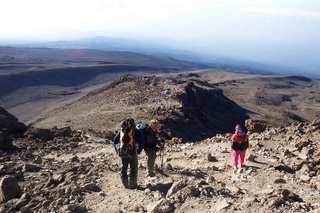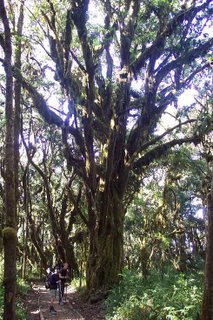
OUT OF AFRICA

(Top) The incredibly common bunch of idiots pretending to be leopards in a tree and (above) the real thing.
“He who can visit the Serengetti and does not, is mad.”
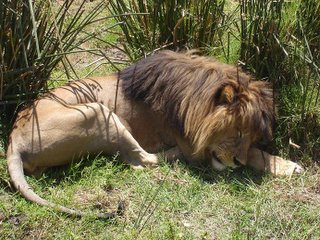
A lion...
Well now having seen it, in my opinion he may have had a slight fondness for hyperbole but it was essentially this quote that eventually swung me into joining Pat and Andrew for a four day safari (another one) through the most famous park in Africa immediately upon our return from climbing Kili. There is just something about the name Serengetti; everybody has heard about it whether it be from books at school, copious (Sir) David Attenborough docos on the ABC or just from watching the Lion King too many times. It was this kind of sub-conscious appeal to see the great plains of the Serengetti (translation: Great Plains) that made me go against my rational thinking (ok, more my tight-ass thinking) which was telling me I’d seen enough animals and that there was plenty more to see in Africa (and that of course it would be nice not to spend that $700….)
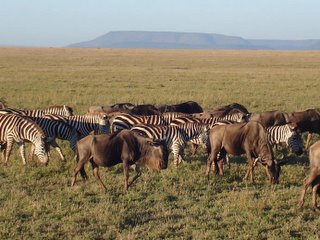
The plains of the Serengetti and below the beautiful Ngorogoro Crater.
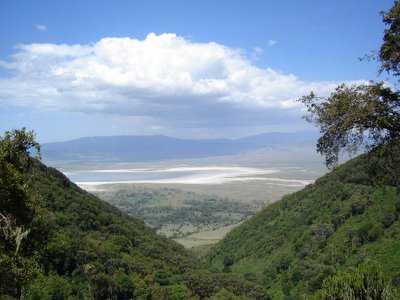
Firstly I will say that the Serengetti is indeed beautiful and I did have a good time on the safari despite my constant fretting as to my rapidly plummeting bank account. Despite the fact that the park was not teeming with wildlife as we had hoped (in fact the scariest set of teeth we saw over the four days belonged to our guide and driver Michael, dental hygiene in Tanzania leaves a lot to be desired) we did nonetheless have some wonderful sightings and I must admit the seemingly endless plains of the park in all directions is a sight to behold, as is the spectacular Ngorogoro Crater, a long extinct volcano some 20km in diameter and 600m deep which is flooded with game.

I may have been happy to just photoshop an image like the one above of us overlooking the Crater. It is an incredible sight however.
Below, the carpark at the entrance to Serengetti National Park, a good start at least.

An important fact that one tends to forget when booking a safari however is that the Serengetti is a long way from Moshi. Basically Toto (the band) are full of shit. I guess that they are technically correct when they sing that “Kilimanjaro rises like an empress/leopress/whatever above the Serengetti” but that tends to infer that it rises from within the Serengetti, or at least close to, not some 400+ frickin km away from it. Hence it basically means that for $700, you get a four day safari, of which two are essentially spent on getting to the damn place. Don’t forget that this was a budget tour (they even  made us set up our own tents, quite barbaric) but just like on Kili, the Tanzanian government knows how to sting the tourists. So yeah, the park is beautiful but at a saving of $700 I occasionally thought that I would have been satisfied looking at a few photos instead.
made us set up our own tents, quite barbaric) but just like on Kili, the Tanzanian government knows how to sting the tourists. So yeah, the park is beautiful but at a saving of $700 I occasionally thought that I would have been satisfied looking at a few photos instead.
Not only did we have to set up our own tents, they fed us mutant fruit like this siamese banana. Actually the food wasn´t too bad.
 Our awesome leopard sighting onece he had descended from the tree. We of course had to share the experience with about a thousand other trigger happy tourists (below-even worse than in Kenya) but of all the vehicles in all the park he had to walk in right in front of ours. Magic.
Our awesome leopard sighting onece he had descended from the tree. We of course had to share the experience with about a thousand other trigger happy tourists (below-even worse than in Kenya) but of all the vehicles in all the park he had to walk in right in front of ours. Magic.
There were several highlights however which made the trip worthwhile apart from the natural beauty of the landscape. For starters, we enjoyed one of the best leopard sightings imaginable on our first day when we were merely driving to our camp, Michael was a total champ and let both me and Pat drive our pimpin’ landcruiser for extended periods through the park (highly illegal of course) and we got to spend a night in a totally secluded campsite which we had to ourselves. I would say that it was exciting knowing that any wild animal could have been right outside our tent, but if what we actually saw during that day during our drive was anything to go by, the greatest risk we faced was being nibbled by a grazing antelope.

Me driving through the Serengetti and a typical African sunset from our secluded camp.

The most memorable experiences for me however were the few close encounters we had with some mighty big game. At a bend in a particular river in the park, there is a huge hippo and croc population and surprisingly we were actually allowed to get out of the vehicle and head down to the bank. Whilst admiring some lazy crocs (thankfully the crocs always seemed to be on the other side…) a lone hippo who had been underwater no more than 20-30m away from us seemingly took a distinct disliking to our presence and commenced a rapid beeline for our location.

Suffice to say, with visions of becoming another statistic contributed to the most deadly animal in Africa, and without a hint of valor or regard for my fellow safaristers, I ran and kept running away up the bank in sheer unadulterated terror over a distance far more than was necessary considering the hippo had stopped no more 10m from where he had started his “rampage”. I just kept on jumping over and through thorns and thickets as if my life depended on it which, for that moment at least, I was sure that it did. Ah yes, you really do discover yourself whilst traveling.
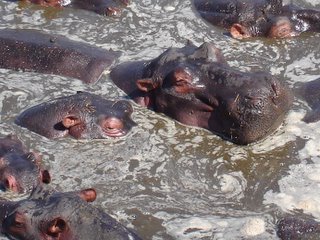 Hippos, grumpy and surpisingly quick over 10m.
Hippos, grumpy and surpisingly quick over 10m.
Another situation we encountered that seemed decidedly lacking in any health and safety precautions was at the spectacularly located camp we stayed at on the rim of Ngorogoro crater. Just milling about amongst the facilities were two elephants, one a massive bull and it was up to people’s individual discretion as to just how close you could get the creature. No guards, no guns, nobody of responsibility telling those deluded souls who were actually trying to touch the bull under the premise that “they loved animals but”, to get the hell away. Eventually the bull got a little sick of the attention and made it quite clear through some very forceful gestures that there would definitely be no patting going on. After raiding the drinking water tank of probably a hundred litres, he was on his way.
 The wandering bull... I´m very comfortable with his presence obviously.
The wandering bull... I´m very comfortable with his presence obviously.
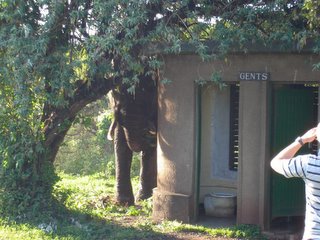
Well, it´s kind of urgent but I guess I can wait. Please, after you...

I’m sure there would have been several more highlights on our dawn drive into the crater from this camp but unfortunately while everyone else was spotting the extremely rare black rhino and watching a cheetah kill, Pat, Andrew and I were left hanging about a deserted campsite for three hours waiting for Michael to pick up a spare tyre and fix other various problems with our vehicle. Fortunately we did get to see the crater once all the animals had retreated from sun (and hence totally out of sight) and of course despite the late start, we were still one of the first to leave and embark on our long 5 hour journey home, a journey that turned out to be a mere taste of what the next few days were to have in store for me.
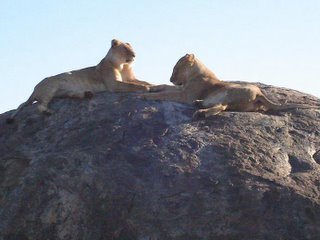
More lions...
 "Honey, I don´t seem to be able to get my door open." "Hmm, I think I see your problem."
"Honey, I don´t seem to be able to get my door open." "Hmm, I think I see your problem."
The problem I then faced after returning to Moshi was (apart from being seriously poorer) was that instead of 12 days to try and encompass both the enticing Zanzibar Island and Uganda, I had only 8 before needing to return to Kenya for my flight back to London. This posed quite the conundrum as if you were to look up East Africa in an atlas, you would see that the two destinations are a considerable distance apart, especially considering the state of Kenya’s highways. Basically for me to cover both (without flying – domestic air travel in Africa is similarly exorbitant), I faced the prospect of bussing it down to Dar Es Salaam (the pseudo capital of Tanzania), ferrying across to Zanzibar, ferrying back, another bus all the way to Kampala via Nairobi and then finally bussing back to Nairobi for my flight. A nightmarish schedule and a suicidal undertaking but as I was not planning to be back in East Africa any time in the near future and with not a minute to spare, I embarked for Dar on a 9 hour journey.
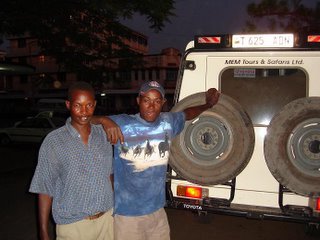
Our awesome guide and cook, Michael and Abu respectively.
One of the most pleasant and welcome surprises I experienced during my time in Africa was the quality of the bus services, at least the ones I took. (I learnt from my Indian experiences – tourist buses only). Overall an entirely comfortable journey with fully sealed air-conditioning, two hostesses serving drinks and snacks and some fine quality entertainment on the not one but two screens. The only drawback was that when not showing such fine fare as Mrs. Doubtfire and Eddie Murphy’s Haunted Mansion, they would occasionally show some Nigerian produced soap dramas which I’m still trying to decide whether they were comedies or not. I’d like to give it the benefit of the doubt and believe that central African cinema in general produces many fine parodies of exceptionally bad films, but either way I do not think that you will see anyone making an acceptance speech in Swahili at the Oscars for best foreign language film anytime soon.
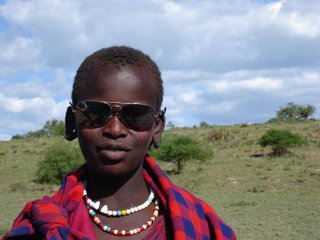 Arguably the baddest Masai dude I´ve ever met. I was tempted to give him (I think it was a him) my aviators because he looked so damn cool.
Arguably the baddest Masai dude I´ve ever met. I was tempted to give him (I think it was a him) my aviators because he looked so damn cool.
Anyway, after a not too bad bus ride, a night in arguably the dodgiest hostel in Dar, and 3hr journey on the 1 and ½ hr ferry, I found myself in Stonetown, Zanzibar. Any nagging regrets about undertaking the costly Serengetti excursion were immediately amplified as I stepped ashore. Put simply, Zanzibar is awesome. An old trading island with a primarily Muslim population, Zanzibar is known as the Spice Island and also as the vanquished party in the shortest war in history. I think in around 1890 odd, the sultan or whatever the ruler of Zanzibar was, declared war on Britain in the morning and surrendered that after lunch.
 In my brief time in Zan, I really didn´t take enough photos, particularly of the beaches. This one (from Stonetown) is about the only one I have but I assure you the sand is much whiter away from the city.
In my brief time in Zan, I really didn´t take enough photos, particularly of the beaches. This one (from Stonetown) is about the only one I have but I assure you the sand is much whiter away from the city.
The name Zanzibar itself evokes many exotic images and Stonetown, the capital, lives up to these by itself with its white beaches, classic Muslim architecture, narrow streets, bustling markets and bazaars, incredibly tasty seafood and somewhat unfortunately, its accompanying slight stench of fish. You can easily just wander about the place getting lost in its labyrinth of streets all day which I proceeded to do until my limited time dictated that I get to the tourist haven of Nungwi, a beach town on the northern tip of the Island.
Although primarily a Muslim population, there is significant Christian influence also. This is my attempt at capturing the symbolism of religious harmony. I´m an artist, I know.

 I loved my oh-so-brief time in Nungwi, the place is typically beautiful, postcard white beaches lapped by turquoise blue water, the seafood is again brilliant and I was fortunate enough to meet up with not only a great couple I had met up with on the Kili climb but also a bloke I went to high school with of all people and his overland crew. Few better places to have a beer with good company than from one of the many balconies extending over the beach whilst watching the sun set over the water.
I loved my oh-so-brief time in Nungwi, the place is typically beautiful, postcard white beaches lapped by turquoise blue water, the seafood is again brilliant and I was fortunate enough to meet up with not only a great couple I had met up with on the Kili climb but also a bloke I went to high school with of all people and his overland crew. Few better places to have a beer with good company than from one of the many balconies extending over the beach whilst watching the sun set over the water.
One of the many narrow streets typical of Stonetown.
Zanzibar is also famous for its diving and although only snorkeling, I did get to experience a small taste of what Zanzibar had to offer beneath the water. I certainly picked my day for it, I happened to be on the island during some massive tidal swells that were hammering the coast (some of those aforementioned balconies actually collapsed or had severe structural damage during the night). Ours was the only boat that headed out that day into what I’d be guessing to be 1.5 to 2m swells. I know that isn’t exactly the “high seas” but when I say boat, I mean a slightly large wooden canoe with a single outboard. Quite the rough but very enjoyable 2 hour journey out to the reef island made all the more humorous when we had to stop to allow American Neale, who had had a fairly big night, to perform the delicate aquadump procedure in the large swells. ‘Twas very amusing to see him bob up and down like a cork in the ocean, his face straining from the effort whilst simultaneously swiping at any floaters that came to close. The snorkeling by the way was beautiful but admittedly nothing on what I remember of the Great Barrier Reef.
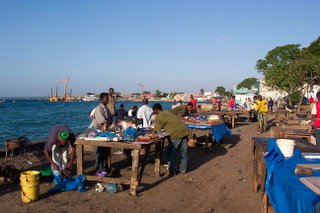 The outdoor vendors of Forodani Gardens, Stonetown, providers of some mighty fine seafood at some mighty fine prices.
The outdoor vendors of Forodani Gardens, Stonetown, providers of some mighty fine seafood at some mighty fine prices.
Alas after only two nights on the Island, I finally decided that I would make the effort to catch up with Pat, whom I had split up with in Moshi, one last time in Uganda before leaving him behind in Africa. It sounded reasonable in theory at the time but that little flush of sentimentality was to propel me on quite the memorable journey.
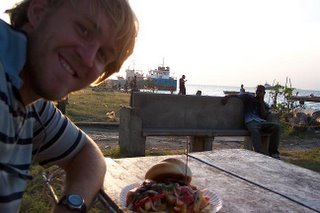 My last supper, I think I paid around $4 for a meal that included beef, prawns, snapper and lobster. Mmmm, lobster.
My last supper, I think I paid around $4 for a meal that included beef, prawns, snapper and lobster. Mmmm, lobster.
First up was a 2 ½ hr dulla dulla (truck/bus common throughout Zanzibar) back to Stonetown to buy my ticket for the overnight ferry (the longest but cheapest journey). I had arranged to catch the same ferry with a Kiwi, Nick but I began to feel something was awry when he asked me whether I had purchased a first class seat when I had been offered no such thing. Surely there wouldn’t be two boats leaving at 10pm in the evening?
After enjoying my “last supper”, a fabulously cheap and tasty assortment of seafood and chips from the outdoor vendors along Forodani gardens (my last highlight for many hours), I made my way along the harbour towards my ferry, past the huge cargo ships, past the high-speed cruisers, past the rusted out floating cattle barge, past the…oh wait minute, that’s my ferry. Hmmm, it seems distinctly lacking in a first class cabin or an enclosed roof for that matter. Oh and it seems to have people spilling over the sides. And what’s more, I notice that I don’t actually have a seat specified which is unfortunate as every single seat and inch of aisle space is taken up by locals who I am absolutely positive did not pay US$15 for the privilege.
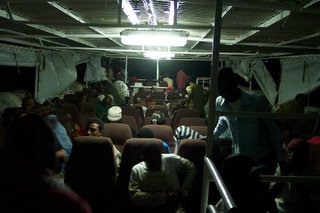 The magnificent vessel "the Flying Horse", surely one of the finest in the P´n´O fleet.
The magnificent vessel "the Flying Horse", surely one of the finest in the P´n´O fleet.
What a night. Memories of my horrible bus ride to Bikaner in India came flooding back as I stood on that barely floating shitbox, but I eventually found some space UNDERNEATH a bench seat some 40 cm high and that is where I stayed for the following nine hours. I had feet in my face, my feet in other’s faces, I was trying to stabilize myself on my painfully sunburnt elbows against the violent rocking of the boat all night, all whilst at the same time trying to keep a tired eye on my bags which were in a pile some metres away. For NINE HOURS. At the very least the ferry was on time and I was able to rendezvous with my bus to Kampala, where I again met up with Nick who had great pleasure informing me that his ride (for the same price) was most pleasant in the first class cabin of his boat, where there was plenty of space and many comfortable couches to choose from.
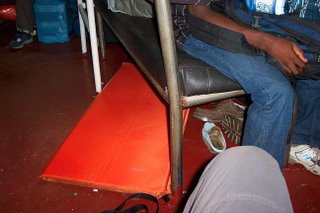 My "seat". Thank God for the thermarest.
My "seat". Thank God for the thermarest.
The worst part of the journey over, now the simple matter of catching a mere 34 hour bus trip to Kampala…
I could wax lyrical indefinitely about that particular bus ride, an undoubted highlight of my journey, but in the interests of readability I shall refrain from doing so apart from telling you that it took even me by surprise the degree of general funk one can generate by sitting in the one position over such a period. Fortunately I had the company Pommie Dave, a young zoologist/guide extraordinaire and some high quality cinema (does “Money Train” do anything for you? How about “Paparazzi - when the celebrities strike back”?) to keep me entertained.

Kampala, actually quite a beautiful city, one that I´m sure would grow on you if you spent more than 2 1/2 d days there.
Upon our eventual arrival in Kampala, Dave and I ventured into the city’s incredibly bustling streets in search of a functioning ATM to provide us some much needed Ugandan shillings. Now I don’t know about you, but I’ve never waited in a queue for an ATM more than say 2 people long, so Dave and I were slightly taken aback to discover some 200 people (at least) lining up at the what we believed to be the only bank capable of accepting visa cards.


This massive queue for only 2 ATM facilities puts even the Brits to shame.
In general, I’ve never been in a city that felt so overflowing with humanity, on every street there were people spilling out onto the road, seemingly wandering about aimlessly, and every vehicle that went by was surely jam packed past the legal limit. I’ve also never been in a third world city that doesn’t have some sort of taxi harass you every 10m. Just when we needed one most, Dave and I continued to contribute to our already mutant funk in the hot and dusty conditions whilst ultimately failing to flag any sort of transport.
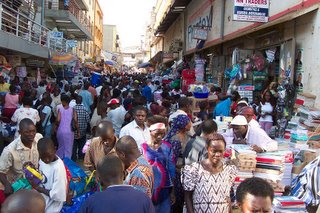 The teeming masses of Kampala...Seemingly every street was chockas.
The teeming masses of Kampala...Seemingly every street was chockas.
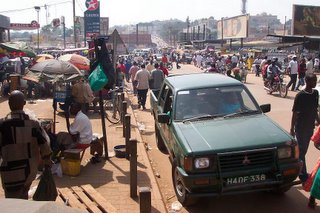
We finally stumbled upon the gargantuan taxi park in the centre of the city, a mecca for the ubiquitous Toyota hiace and it was from here that I was finally able to make it to the backpackers and rendezvous with Pat, some 46 hours after departing my tropical island paradise of Nungwi. In Kampala, apart from the incredibly fun motorcycle taxis, called boda bodas, there are very few taxis operating in the style we are accustomed to, rather you head to the giant taxi park and there are literally hundreds, if not thousands of these vans waiting to go to various locations around the city. Just rock up to the sign indicating your preferred destination, wait for the van to be completely overloaded with passengers and you’re away.
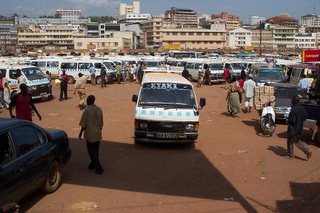 The massive NEW taxi park in central Kampala. There´s actually two such parks in Kampala (yep, you guessed it, the OLD taxi park). Below, we were there in the midst of a federal election campaign and obviously a few rules were bent by the competing parties.
The massive NEW taxi park in central Kampala. There´s actually two such parks in Kampala (yep, you guessed it, the OLD taxi park). Below, we were there in the midst of a federal election campaign and obviously a few rules were bent by the competing parties.

After such an exciting two whole days in transit, it was great to finally a) shower and b) spend a day just doing nothing in particular. Pat, Dave and I headed out for some beers a few times with others from the hostel and we explored the city a little via those aforementioned boda bodas, but in general I pretty much spent my time coming down from my bus-induced high in preparation for my main activity put aside for Uganda.
 Easily the most fun method of transport around Kampala, the boda boda. Both Pat and I are on the same bike so you can imagine it´s a tight squeeze sometimes.
Easily the most fun method of transport around Kampala, the boda boda. Both Pat and I are on the same bike so you can imagine it´s a tight squeeze sometimes.
Uganda pretty much has, as far as my naïve and ill-educated self can tell, two main tourist attractions. Far and away it’s most popular (and lucrative) is it’s large (relatively speaking of course) gorilla population in Bwindi National Park and secondly is the incredible rafting on offer on the source of the Nile. I shall regret for a long time that I booked my flights for such a short period in Africa thus preventing me undertaking the opportunity to see the gorillas (two months booking in advance is generally required and you’re looking at a cool US$375 for ONE hour with the gorillas) but the rafting proved to be an admirable replacement. (Incidentally Pat stayed on in Africa following my departure and spent an hour with the gorillas in Rwanda. He has some great photos on his blog which you can check out at http://www.pmolon1.blogspot.com/.)
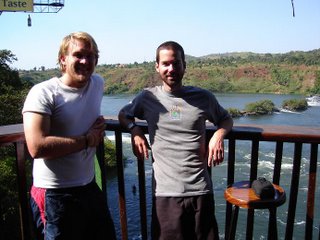
Pat and I overlooking the Nile prior to commencing our rafting trip.
The rapids encountered on the source of the Nile are famous for their ferocity (some, although not navigated commercially, are grade 6, or in simpler terms, certain death) and we had the good fortune of discovering that one poor soul had died the day before our trip. Hardly the start we were looking for and our fears were seemingly intensified following our “forced evacuation” from the raft on the two of the first three rapids encountered. I’ve done a bit of rafting in the past and I can guarantee you I’ve never been in rapids quite as big as those we traversed that day, particularly the last one, known simply as “the bad place”. As a result, it was one of the most fun days of my entire trip, that is, apart from the accompanying trip back to Kampala. It took us some 90 minutes just to cover the last 5km of the journey due the aforesaid teeming masses supposedly flooding the streets in honour of Bob Marley’s birthday. (I tell you I’ve had more than enough of Bob Marley on this trip to Satisfy My Soul, but I think I’d be Waiting in Vain if I expect to gain Redemption from his music upon my Exodus from Africa.)
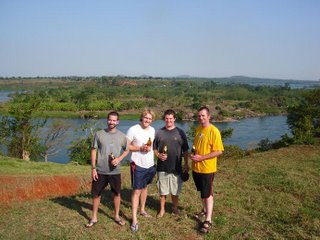 The crew from our boat, Pat, me, Safari Dave and Brit Julian.
The crew from our boat, Pat, me, Safari Dave and Brit Julian.
Alas seemingly as soon as I had arrived in Uganda I was forced to depart once again for Nairobi (not surprising considering I had all of 2 ½ days in the country). It was a sad moment to be parting with Pat, my traveling companion for some 4 ½ months and I shall take this opportunity to thank him briefly for his company and friendship over that period. I could not have asked for a more patient, considerate and enjoyable cohort and Pat, if you read this, I hope we can do it all again some day.
 Shall be a while between drinks... Pat and my last beer together.
Shall be a while between drinks... Pat and my last beer together.
All that was left for me was another 15 hour bus trip back to Nairobi, a pleasant night and day spent in the company of some Swedish girls (just call me the Shermanator) and then I was on a plane back to London, taking me out of Africa.
Cheers.





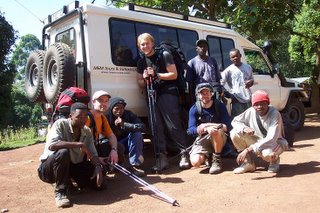

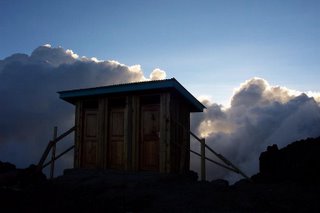
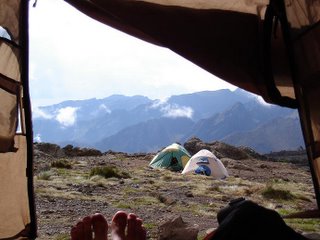

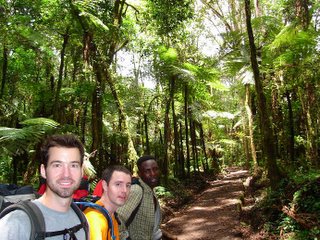


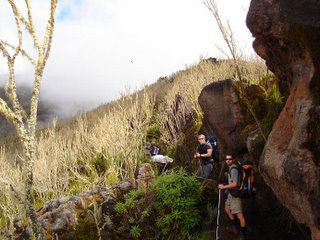

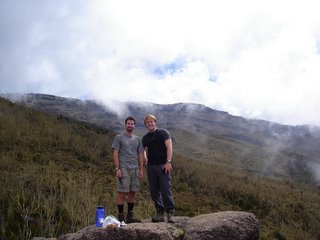


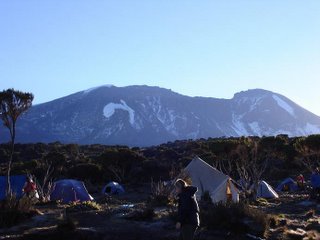


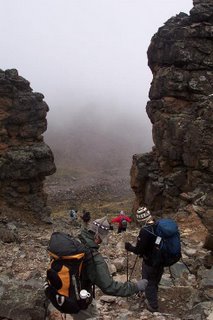


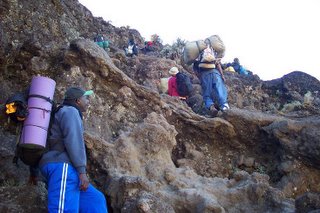
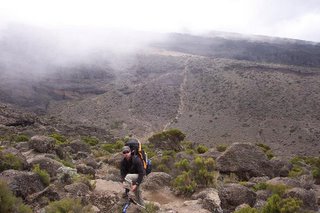










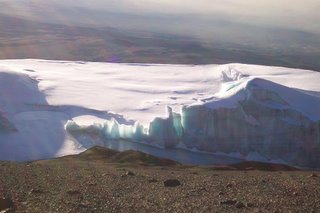
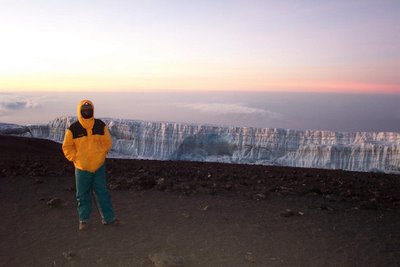 Glaciers, glaciers, and more glaciers. Stunning. That´s Eugene above.
Glaciers, glaciers, and more glaciers. Stunning. That´s Eugene above. Above is me taking my celabratory shot of whiskey and the three of us below all smiles despite the difficulty in moving anything on our faces.
Above is me taking my celabratory shot of whiskey and the three of us below all smiles despite the difficulty in moving anything on our faces.
 Pat and I after fulfilling our main ambition of the whole trip. Below is Eugene taking his whiskey shot. He was quite a fan we found out when we took him for drink upon returning to Moshi....
Pat and I after fulfilling our main ambition of the whole trip. Below is Eugene taking his whiskey shot. He was quite a fan we found out when we took him for drink upon returning to Moshi....



 You have no idea how much I was leaning on those poles. I was wells buggered.
You have no idea how much I was leaning on those poles. I was wells buggered.